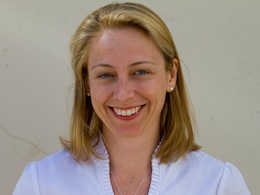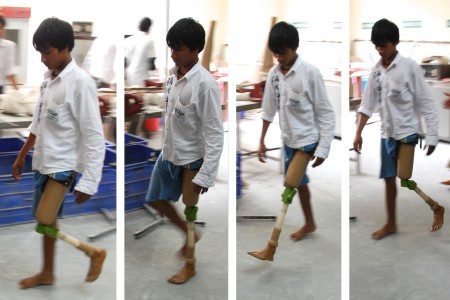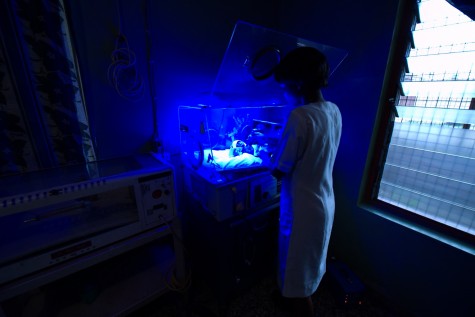D-Rev’s Design Sense: Connecting World-Class Products With World Needs
To say Krista Donaldson, the CEO of Design Revolution, has a multi-disciplinary background would be something of an understatement. She previously served as a diplomacy fellow at the U.S. State Department where she worked on economic policy and the reconstruction of the country’s electricity sector. Formerly a design engineer and researcher with KickStart International, Donaldson also has worked with socially focused design firm, IDEO.
I interviewed Donaldson, a PopTech fellow, on the sidelines of PopTech 2011. (Check the PopTech 2011 highlights in this NextBillion post ).
).
NextBillion.net: Can you tell me about Design Revolution in a nutshell?
Donaldson (Pictured left): The short answer is we are a technology incubator focused on providing options for people living on less than $4 a day. We identify specific social needs – opportunities for consumers to improve their health or generate income – and design and deliver affordable, yet world-class products to meet those needs and ultimately, improve lives.
NextBillion.net: Tell me about the history of D-Rev as an organization?
Donaldson: D-Rev was founded by Kurt Kuhlmann, a technologist, and Paul Polak of IDE fame on the idea that there are not enough designers and innovators out there focusing on creating products that fulfill the basic needs of people living in extreme poverty. I took the CEO position in 2009 and the first thing I did was focus our product pipeline on bringing products – like Brilliance and the JaipurKnee (pictureed left) – to scaled impact. One product, a solar concentrator, was spun-off to become the independent for-profit Rise Solar and we took an equity stake. Two other projects went on hold. I wanted us to move beyond creating ’cool’ technologies to ensuring these products have a real impact on people’s lives. Recognizing a lot of due diligence needs to happen at the beginning of a project to ensure delivery into the market has been key. For example, with Brilliance, the user is not the customer. The users are nurses or doctors and also, newborn patients, but the purchaser is often someone different, such as a ministry of health official. So understanding that dynamic is key.

NextBillion.net:: You said something really profound: that the point is not to develop technologies but to have impact. And often all this energy goes into the due diligence process to ensure that the product will have impact, and often that impact falls short when it hits the ground.
Donaldson: I would argue that usually there is not enough due diligence. To develop a project you need to spend more than two weeks with the people you’re designing for in their environments. You need to visit tens, if not hundreds of stakeholders. With Brilliance we visited hundreds of clinics and hospitals, and actually shifted gears because we found that the need we originally identified was not actually the most practical place to start in addressing newborn disability and death resulting from jaundice. In the design world we call due diligence “need-finding,” but traditional user-centric need-finding does not include things like market analysis and price point determination. If more research happened in the earliest phase of the design process we’d see more impact from these types of products.
NextBillion.ne: And you are not just taking these products through the design process, but also to market, right?
Donaldson: Yes, our design process is the entire product life-cycle: design, manufacturing, delivery, marketing, sales, scaling. You need to know where you want to go and how you are going to get there when you start. This influences the entire project: for example, when you are getting ready to come up with the proof-of-concept for a product you need to understand the key features that are important to users and the market. You need to know how to make tradeoffs. For example, if you are developing a product for rural settings in India and its sustainability is dependent on for-profit organization, it is often not profitable for that company to send a repairman into remote areas. So what tradeoffs must be made? Maybe the product needs to be designed so that a replacement device can be easily couriered in and out. In order to have sustainable impact in the long term, you must understand the tradeoffs in the earliest stages of the design process.
NextBillion.net: In what capacity do you work with the local communities who will be the recipient of your products?
Donaldson: We work as much as possible with our end users and partners – and while we could be based anywhere, we keep an office in Palo Alto so that we have access to a broad range of expertise, materials for rapid iterations and prototyping (in many of the communities where I’ve worked, such as Iraq or Tanzania or India, it is difficult to source materials quickly and efficiently). We can quickly translate the latest R+D into practice in Silicon Valley, while in parallel working with local partners to determine the optimal delivery model for maximized impact.
NextBillion.net: When you are designing a product, does D-Rev seek out problems or do clients come to you with a problem to solve?
Donaldson: Both. Our projects come from many sources, but our favorite is when partners approach us with a problem. We always want to start with a need, but often people come to us with a solution. So we step back and ask, “What is the need we are trying to address here?” For example, someone might say people living in rural areas need a cheap light. Well, light is a solution, so we search for the need, which could be that someone wants to keep their business open longer or children are unable to do homework when the sun goes down. So we try and understand the true need or needs. And because we take a market-based approach we must then determine if there is a market for this product. We will investigate what that market may look like, what the price point is, if it can be made profitably, and what the supply chain and distribution channels look like. We try to get as many needs as possible so we can filter projects and focus on those that have the most potential for sustainable and scalable impact.
(Check out Donaldson’s Popcast from this year’s PopTech below):
NextBillion.net:: Thank you Krista. I have one final question for you: Why do you do what you do?
Donaldson: I struggle with this question, because I am one of those people who has intrinsically always wanted to do this. I can be overly sensitive and cry at commercials, yet can mostly stand back from my work with some emotional separation (otherwise it can be heartbreaking). Ben Cline, who started our jaundice projects, and I were at a hospital not long after I had my second child. At the hospital you could see babies, so small one could literally fit in your hand, and you see them on life support and know that some of the treatment they are getting is not effective. This is hugely painful, especially as a parent. It was hard for me in the first six hospitals we visited, and it is still hard. When you see a premature baby with translucent skin lying in a plexi box with parents unable to touch their baby you really see that this is a human life. To have an impact on the situation, you have to be able to step back from situation and the numbers and think things through. For me, I want people everywhere to have access to good healthcare and opportunities that will enable them to improve their lives. And that’s why I do this.
- Categories
- Health Care
- Tags
- product design

